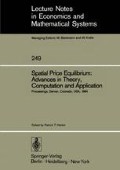Abstract
Spatial models of market equilibrium for use in policy analysis often require inclusion of multiple objectives. This becomes a problem in multi-level programming for which there are not yet effective algorithms for large-scale models. This paper reports use of a heuristic method for developing non-dominated alternatives, using a two-level approximating and incorporating experimental design techniques. The analysis is of alternative pricing policies for the 1985 U.S. Farm Bill.
Access this chapter
Tax calculation will be finalised at checkout
Purchases are for personal use only
Preview
Unable to display preview. Download preview PDF.
References
Ballinger, N. 1984. An analysis of Mexican trade policy. Ph.D. dissertation, Department of Agricultural Economics, University of California, Davis.
Box, G.E.P. and Wilson, K. B. 1951. On the experimental attainment of optimal conditions. Journal of the Royal Statistical Society, Ser. B 13:1–45.
Candler, W. and Norton, R. 1977. Multi-level Programming and Development Policy. Washington D.C.: World Bank Staff Working Paper 250.
Candler, W., Fortuny-Amat J., and McCarl, B. 1981. The potential role of multi-level programming in agricultural economics. American Journal of Agricultural Economics 63,3: 521–31.
Candler, W. and Cartwright, W. 1969. Estimation of performance functions for budgeting and simulation studies. American Journal of Agricultural Economics 51, 1.
Chanchong, V. and Haimes, Y. 1983. Multiple objective decisionmaking. New York: New Holland.
Cohon, J. 1978. Multiobjective programming and planning. New York: Academic Press.
Duloy, J. and Norton, R. 1975. Prices and incomes in linear programming models. American Journal of Agricultural Economics 57, 4: 591–600.
Erickson, E. E. and House, R. M. 1984. Multiple objective policy analysis: A factor analysis and tradeoff approach applied to the agriculture sector of the Dominican Republic. Journal of Policy Modeling Sept.:1–19.
House, R. 1984. USMP regional agricultural programming model: theoretical and data description. Washington D.C.: U.S. Department of Agriculture, ERS Technical Bulletin (forthcoming).
Kleinjen, J.P.C. 1977. Design and analysis of simulations: practical statistical methods. Simulation.
McCarl, B. and Spreen, T. 1980. Price endogenous mathematical programming as a tool for sector analysis. American Journal of Agricultural Economics 62, 1: 87–102.
Miller, T. A., Sharpies, J. A., House, R. M., and Moore, C. V. 1984. Implications of increasing world grain market fluctuations on U.S. agriculture. Washington D.C.: U.S. Department of Agriculture, ERS Agricultural Economic Report (forthcoming).
Montgomery, D. 1984. Design and analysis of experiments. 2nd Edn. New York: John Wiley.
Myers, R. 1971. Response surface methods.
Naylor, T. 1970. Computer simulation experiments with models of economic systems. New York: John Wiley.
Norton, R., Santaniello, V., and Echevarria, J. 1983. Economic evaluation of an agricultural sector investment program: a case study for Peru. JOURNAL OF POLICY MODELING.
Samuèlson, P. 1952. Spatial price equilibrium and linear programming. American Economic Review 42, 3:283–303.
Schruben, L. 1984. Operations Research Department, Cornell University, private communication.
Steinberg, D. and Hunter, W. 1984. Experimental design: review and comment. Technometrics 26, 2.
Theil, H. 1961. Economic forecasts and policy. Amsterdam: New Holland.
Willis, C. E. and Perlack, R. D. 1980. A comparison of generating techniques and goal programming for public investment in multiple objective decisionmaking. American Journal of Agricultural Economics 62, 1: 66–74.
Zionts, S. 1984. Multiple Criteria decision making: an overview and several applications. Paper delivered at the VIth International Conference on Multiple Criteria Decisionmaking, Case Western Reserve University, June 4–8, 1984.
Author information
Authors and Affiliations
Editor information
Editors and Affiliations
Rights and permissions
Copyright information
© 1985 Springer-Verlag Berlin Heidelberg
About this paper
Cite this paper
Erickson, E., House, R. (1985). Multiple Objective Analysis for a Spatial Market System: A Case Study of U.S. Agricultural Policy. In: Harker, P.T. (eds) Spatial Price Equilibrium: Advances in Theory, Computation and Application. Lecture Notes in Economics and Mathematical Systems, vol 249. Springer, Berlin, Heidelberg. https://doi.org/10.1007/978-3-642-46548-2_10
Download citation
DOI: https://doi.org/10.1007/978-3-642-46548-2_10
Publisher Name: Springer, Berlin, Heidelberg
Print ISBN: 978-3-540-15681-9
Online ISBN: 978-3-642-46548-2
eBook Packages: Springer Book Archive

